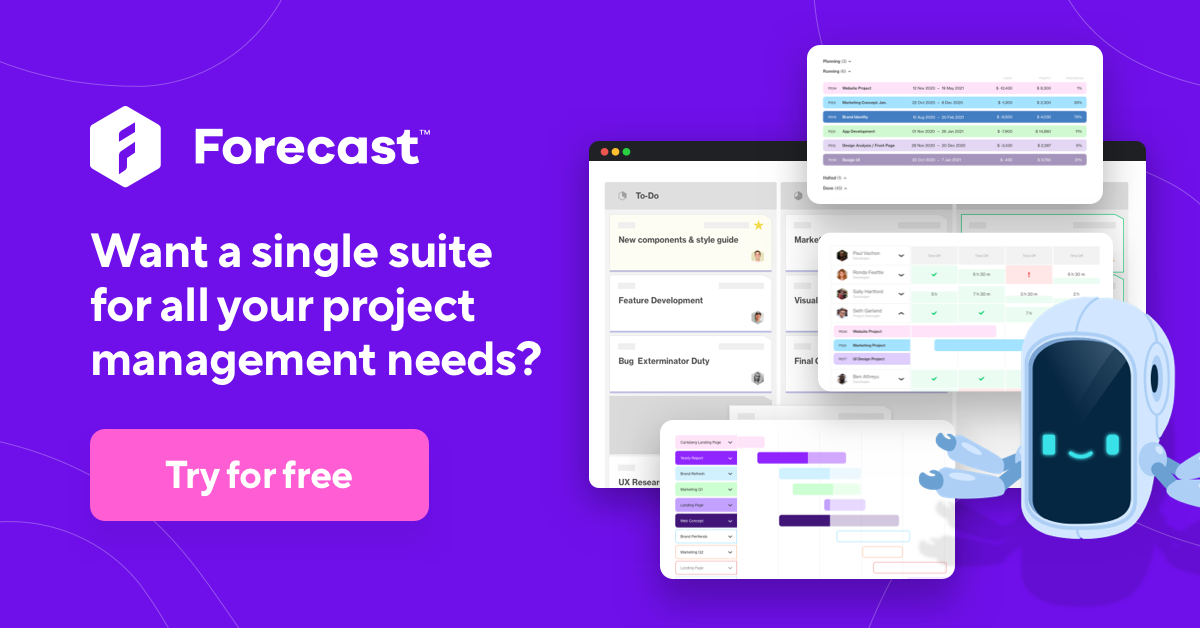Getting Started With a Kanban Board: 6 Tips for Productive Work

A Kanban board is one of the most common ways to collaborate on a project today. Kanban board columns such as “To do,” “In progress,” and “Done” are so recognizable that people rarely have any trouble building a Kanban board or understanding it. Some even can’t imagine their lives without it! However, it’s as easy to grasp Kanban as lose control over it, so we’ve made this five-minute guide with the best tips to build a Kanban board and stay on track with your task management.
- What is a Kanban board?
- The benefits of Kanban boards in project management
- Types of Kanban boards
- Kanban vs scrum board
- 6 tips to work productively with Kanban boards
- Best Kanban board software
What is a Kanban board?
Let’s run through the basics first. So what is a Kanban board? Atlassian defines a Kanban board as an agile project management tool, designed to visualize work, limit work-in-progress, and maximize efficiency. According to PMI, Kanban boards assist in creating an environment where a minimum of interruptions and transparent communications are paramount.
All of this is achieved through building a simple overview of the workflow that consists of task cards, sorted across different columns, such as to-do, in progress, and done. Every card represents a task, for agile teams it could even be a user story. Each task is located in a column that visualizes its progress or stage in development. Here’s a Kanban board example you will find in Forecast:
Workflow in Forecast
The concept of Kanban was introduced by Toyota in the 1940s, meaning “billboard” or “visual sign.” The idea was to map out work for everyone and make sure the teams stay on the same page. A Kanban board then became the favorite tool of agile teams and was used ever since.
Used to manage workflow and projects in an agile environment, the Kanban method improves communication, collaboration, and productivity by limiting the amount of work-in-progress (WIP). It limits the number of tasks that users can take on by adding new 'cards', thus ensuring that all teams are not overloaded and their tasks can be delivered effectively and efficiently. Kanban boards also help you track the progress toward goals, and identify which obstacles are slowing you down, but more on that in the next section.
The benefits of Kanban boards in project management
Kanban is often compared to the traffic lights on the streets that control the flow of transportation. For project managers, it offers the ability to achieve transparency in the process, see who’s working on what, eliminate bottlenecks, and get more done through focused work.
Whenever a kanban board is implemented, it will shed light on the process, at the same time highlighting any inefficiencies or resource constraints, such as too much work in progress, stalled tasks, tasks being assigned to one person over and over, or missed deadlines.
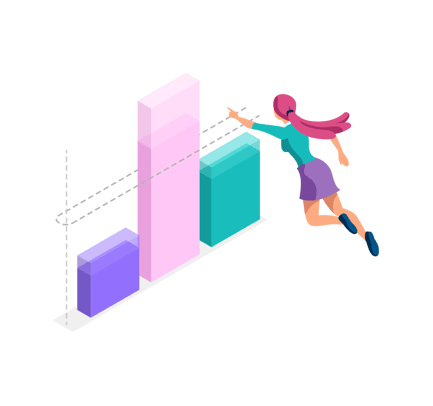
By putting the whole workflow on screen with a kanban board, project managers can eliminate the above, together with other waste that’s coming in. In fact, like no other tool, kanban can save time on unnecessary progress meetings, making the entire flow transparent.
A kanban board is also a savior for each individual team member, as it serves as a tool for organizing all ideas and tasks into a to-do list that doesn’t cross the perimeters of anyone’s capacity. By using a kanban board, project managers can get the ball rolling without interruption and facilitate the smooth execution of tasks.
Types of kanban boards
As you've probably already guessed, depending on how and where a kanban board is implemented, it can be of two types - physical and digital. Both have their advantages and disadvantages. While a physical board can bring numerous benefits to teams that are always on-site, it won’t be an option for managing remote work. Digital boards especially took precedence over physical boards when the world was forced to work from home. Here's an example of a digital kanban board:
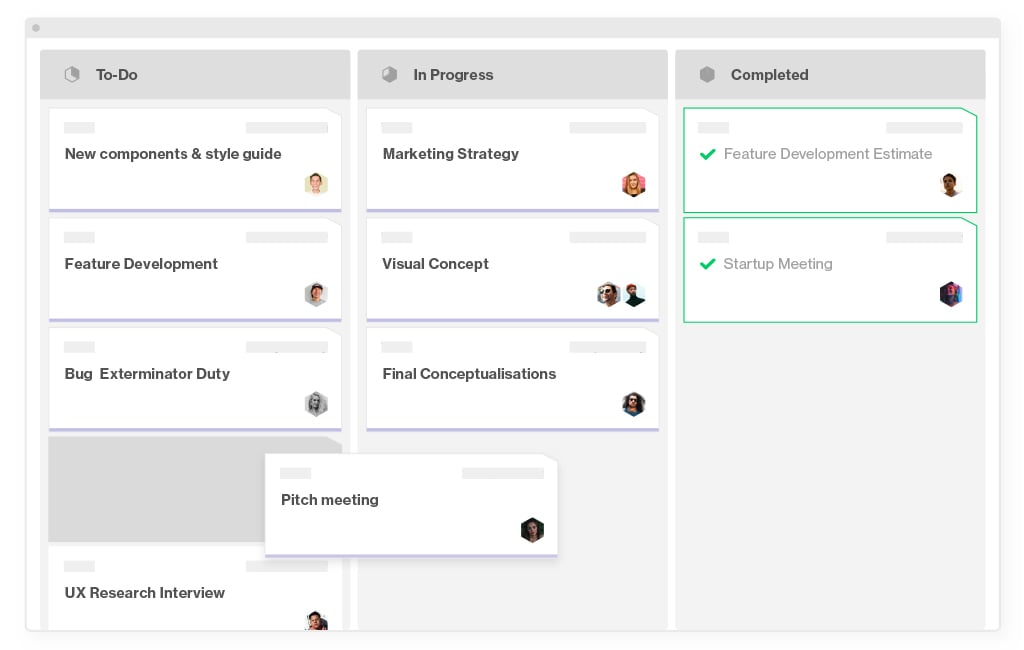
Kanban vs scrum board
Kanban boards can be easily mistaken for scrum boards and vice versa. However, there’s a striking difference between the two. First of all, a scrum board is intended to visualize, prioritize, and track work in sprints, that is, short periods of time. Compared to kanban, it has two columns for keeping the product backlog and sprint backlog organized. Here’s a scrum board in Forecast, where you can easily discern the difference:
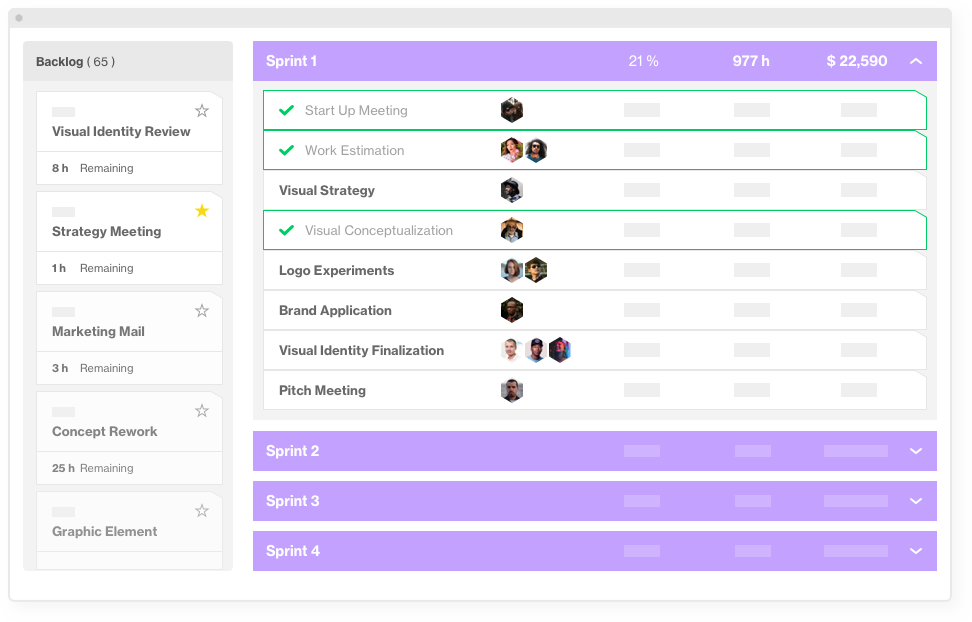
A scrum board example in Forecast
The key difference between Kanban and Scrum boards is that the former ones are not about planning or estimating workload in advance as many would think. Kanban doesn’t limit you to short periods of time to finish work, as it doesn't follow the concept of sprints. A visual representation of your workflow is all that is needed so you can identify problems, and fix them.
Because kanban methodology accepts change as the inevitable part of every project, kanban boards are set up in a way that change can happen at any time. In turn, when working in scrum boards teams are discouraged from making any changes to the sprint forecast. Another fundamental difference between the scrum and kanban board is that the former is managed by product owners and scrum masters, while the latter can be managed by anyone in the team.
Because Kanban is a set of principles for workflow management and visualization, it supports continuous improvement and it enables quick response times so that software teams don’t get trapped in the “analysis paralysis” but, instead, have a high level of flexibility. With Kanban, there’s no need to struggle with product backlogs and sprint backlogs – these are out of scope. Estimating and prioritizing stories won’t be the duties of your team members either.
6 tips to work productively with kanban boards
Kanban doesn’t seem like a lot to handle at first glance, but there’s definitely the right and the wrong way you could work with it. With these six tips, you’ll be able to understand the gist of it and figure out if Kanban is right for you.
1. Map out the value stream
The idea behind every Kanban board is in having columns that would communicate how tasks flow from an idea to completion. To make sure you account for all the stages in the workflow and map out a detailed plan, it’s essential to shadow your employees and understand how tasks are usually handled in the team. When introducing a kanban board, there’s no need to revisit processes internally - your kanban board should rather picture the value stream than introduce changes to it.

2. Have a commitment and delivery point
To get a kanban board off to a good start, decide on the columns relevant for your situation. The problem with too many columns is that eventually you don’t really know where the task belongs, so keep the number of columns as limited as possible. The usual Kanban setup recommends a commitment point - your To-Do list, and a delivery point - the tasks that are done.
Kanban board examples will vary in different teams. Some will have a backlog, but if you notice that every rough idea goes to the backlog, then you could probably benefit from the column dedicated especially to ideas. If the task requires review or testing, create a column for that. Remember, your team members should spend as little time with your kanban board as possible. It doesn’t have to eat too much into their workload or decision-making reservoir.
3. Prioritize tasks and set dependencies
Your Kanban boards can be an organized oasis for all your team members. However, to streamline processes and create a perfect understanding of what to work on next, tasks should be prioritized based on the potential impact.
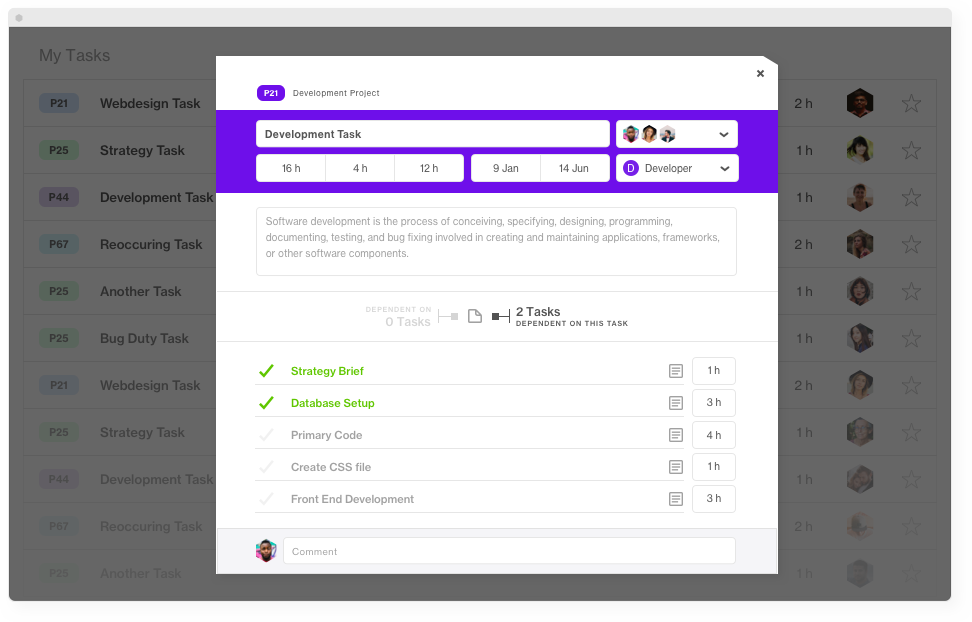
Ever confused on the order at which you are to complete your tasks? Dependencies can change that drab work process into that much needed efficient work process by creating relationships between tasks. You might have a task, which is dependent on a previous task's completion, and thus the task has a "finish-to-start" relationship. Now you and team members won't be confused the dependency relationship will be finished in the correct order.
4. Minimize the number of tasks in progress
One peculiarity with Kanban boards is that they won’t really be effective unless you set work-in-progress limits (WIP). It’s best to have one thing in progress you’re working towards rather than a few tasks you’re switching in-between all the time. Kanban promotes increased focus and prevents you from spreading yourself too thin. In fact, it has been proven by the Little’s Law that the less tasks you have in progress, the better your throughput is.
5. Visualize blocked tasks
There are many ways to spot workflow bottlenecks in kanban, some being more explicit than the others. A good kanban board app should provide you with the opportunity to block tasks and filter the view to see if there’s something stuck. In other cases, you can notice some showstoppers at a column level, especially when tasks proliferate faster than they leave.
6. Align in daily standups
Apart from your planning meetings, kanban boards are often used as a visual tool to communicate progress. They are a great helping hand for managers and employees to understand everyone’s workflow during the standup meeting. In fact, they are so transparent that you’ll eventually reduce time spent on other ad hoc meetings.
Best kanban board software
The software world is crippling with free and paid Kanban board tools. Let’s take a look at some of the best ones.
Forecast
Forecast is a platform for streamlining work processes in project-oriented businesses. With built-in task management, the software provides Kanban and scrum boards for agile teams to see all their tasks in one place and execute on their work. As you enter time on the task, you can immediately see the completion bar fill up. Instead of just tracking task progress based on columns, this granularity gives you the real-time data you need on each task.
c55d.png)
Forecast’s Workflow comes with kanban boards that help to expedite your work process by filtering down your personal view. Everyone can filter their board to see tasks assigned to them without having to look at irrelevant information. You can map dependencies, set priorities, make comments, and attach files to specific tasks.
However, project management doesn’t live with a kanban board alone. To report on the project progress, it’s essential to have a solution that caters to time tracking and finances, or even better, allows you to create Gantt charts and monitor the workloads. Forecast offers a full suite of tools and ensures an end-to-end perspective for delivering successful projects. It comes with a free 14-day trial and is a favorite of agencies, consultancies, and software businesses.
Trello
Trello is a free online kanban board tool that is brilliantly easy to use. A classical solution, it brings the workflow to light providing small teams with the opportunity to create and customize columns, assign people to tasks, and manage work in a recognizable kanban view. Trello’s boards come with the possibilities to set notifications about task deadlines and other common features of Kanban board tools.
Jira
If there was a mountaintop for kanban board apps, Jira would definitely sit there. It is one of the most popular solutions in the world for keeping software teams in sync. Jira has got amazing tools for workflow mapping and issue tracking, and despite the steep learning curve, it has become a favorite of software engineers (not so much of project managers, though).
nTask
nTask is an online Kanban board app with full project management features. It has several features for team collaboration and task management in board, calendar, list and grid view. Users can visualize the task progress in interactive Gantt charts, track time on projects and manage workflows in Kanban Board. It offers numerous pre-built templates to get started for any industry user. Track activity with notifications and get the ability to set Work in Process (WIP) limit.
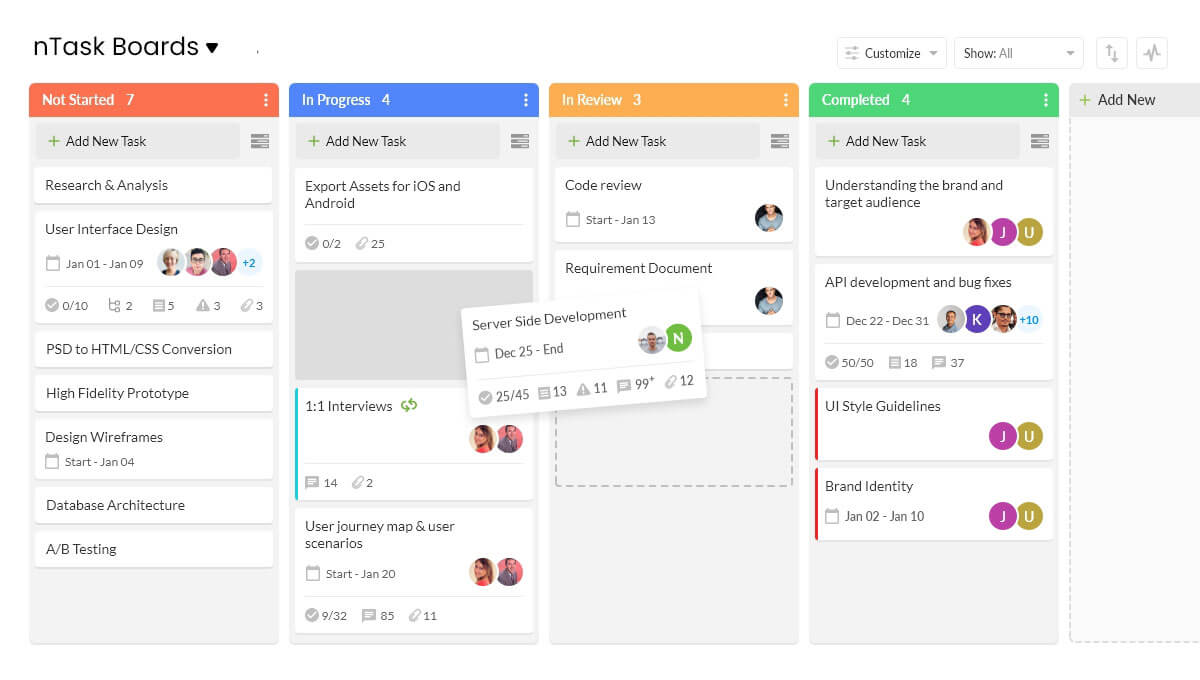
To wrap it up, a Kanban board is a good tool to keep your workflows organized and transparent to everyone. If you haven't tried one yet and struggle to manage work in a spreadsheet, then it might be a good fit.
You might like to read these articles on our blog..
Subscribe to the Forecast Newsletter
Get a monthly roundup of productivity tips & hacks delivered straight to your inbox
